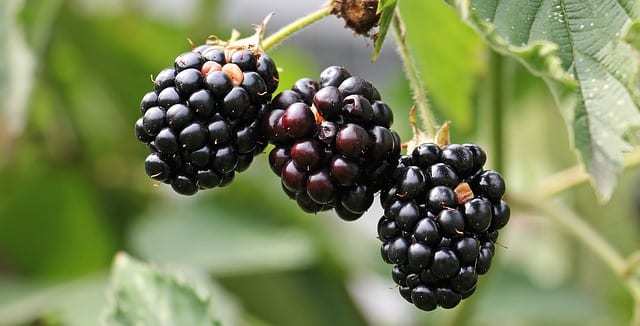Autumn has arrived and with the soft falling of auburn leaves comes an exciting ensemble of seasonal foods, bursting with flavour and nutrients to enrich your body, skin and soul. The beauty of seasonal foods lies not only in their rich vitamin and mineral content, but their easy availability as wild foods, often found growing in carefree and untended in fields, gardens and forests.
In this post we look at a variety of seasonal produce that you can enjoy in the lead up to winter. Consuming seasonal produce is nature’s way of preparing the body’s immune system for the colder months and stocking up on antioxidant-rich foods that are so well equipped to fight disease and age-accelerating free-radicals. Who would have thought one of the best things you could do for your body today was to enjoy a handful of fresh, wild berries on your daily stroll?
Blackberries
Deliciously sweet and of deep purplish hue, blackberries are rich in vitamin E (Alpha Tocopherol), folate, magnesium, potassium, copper, vitamin C, vitamin K and manganese, and a very good source of dietary fibre. They can found growing wild in hedgerows, fields and often in places where the gardener wishes they didn’t. Blackberries, according to legend, shouldn’t be eaten after October 10, upon which date it is said Lucifer was thrown out of hell by St Michael and landed in a bramble bush, where he angrily spat on the blackberries to render them inedible. Devils curse or not, September is typically the best time to pick blackberries before the wind, wet and mould set in. Blackberries are ideal for use in a range of sweet and savoury dishes, from smoothies, sorbets and gateaux to drizzling sauce, marinades and compotes.
Hazelnuts
The delightfully nutty and moreish flavour of a wild hazelnut is something to behold. Steeped in Irish folklore as an enchanted tree that helped to ward off evil spirits, the hazelnut is best harvested in September as they fall off the tree. Providing they are stored in a cool, dry place, they can be enjoyed for some time after. These tiny little nuts really pack a nutritional punch; they are high in monounsaturated fatty acids which are said to help prevent stroke, are an excellent source of dietary fibre, folate, minerals, B-complex groups of vitamins and are very high in Vitamin E, a powerful antioxidant that helps to protect the skin from free radicals. Hazelnuts are often used in sweet dishes and gateaux but are also delicious when enjoyed in autumn salads and poultry roasts.
Crab apples
These elfin forerunners to the cultivated apple variety that we’re used to seeing in the shop are petite and tart by comparison, and most commonly either green or golden in appearance. People in bygone eras believed crab apples could cure warts simply by rubbing the affected area with the fruit and burying it where it would rot and cause the wart to disappear at the same time. Today, crab apples are much better known for having a high Vitamin C, pectin and acid content, making them ideal for fruit jams and chutneys. Like blackberries, crab apples can be used in both sweet and savoury dishes. With a sharp, fruity flavour, they are the perfect complement to rich red meat dishes such as roast duck.
Apples
There is nothing more comforting than sinking your teeth into a fresh, crisp apple picked momentarily from an apple tree. Transport, cold storage and waxing can often diminish the flavour of store-bought apples so to experience the joy of a garden-fresh apple, the fruit is best purchased from farmer’s markets and community gardens where cultivated apple trees are regularly tended. While the common apple might be regarded as just that, they are recognised by health professionals as a super food, giving rise to the proverb “An apple a day keeps the doctor away”. (Interestingly, this renowned saying was first recorded in Wales in the 1860s as “Eat an apple on going to bed, and you’ll keep the doctor from earning his bread”). Loaded with vitamin C and dietary fibre, research studies have shown that apples help to prevent asthma, cancer, stroke, heart disease and even lower bad cholesterol. Apples are also packed with antioxidants which mop up the free radicals that cause disease and aging effects on our skin.
This post appeared first in the Bee Loved Skincare Blog.




